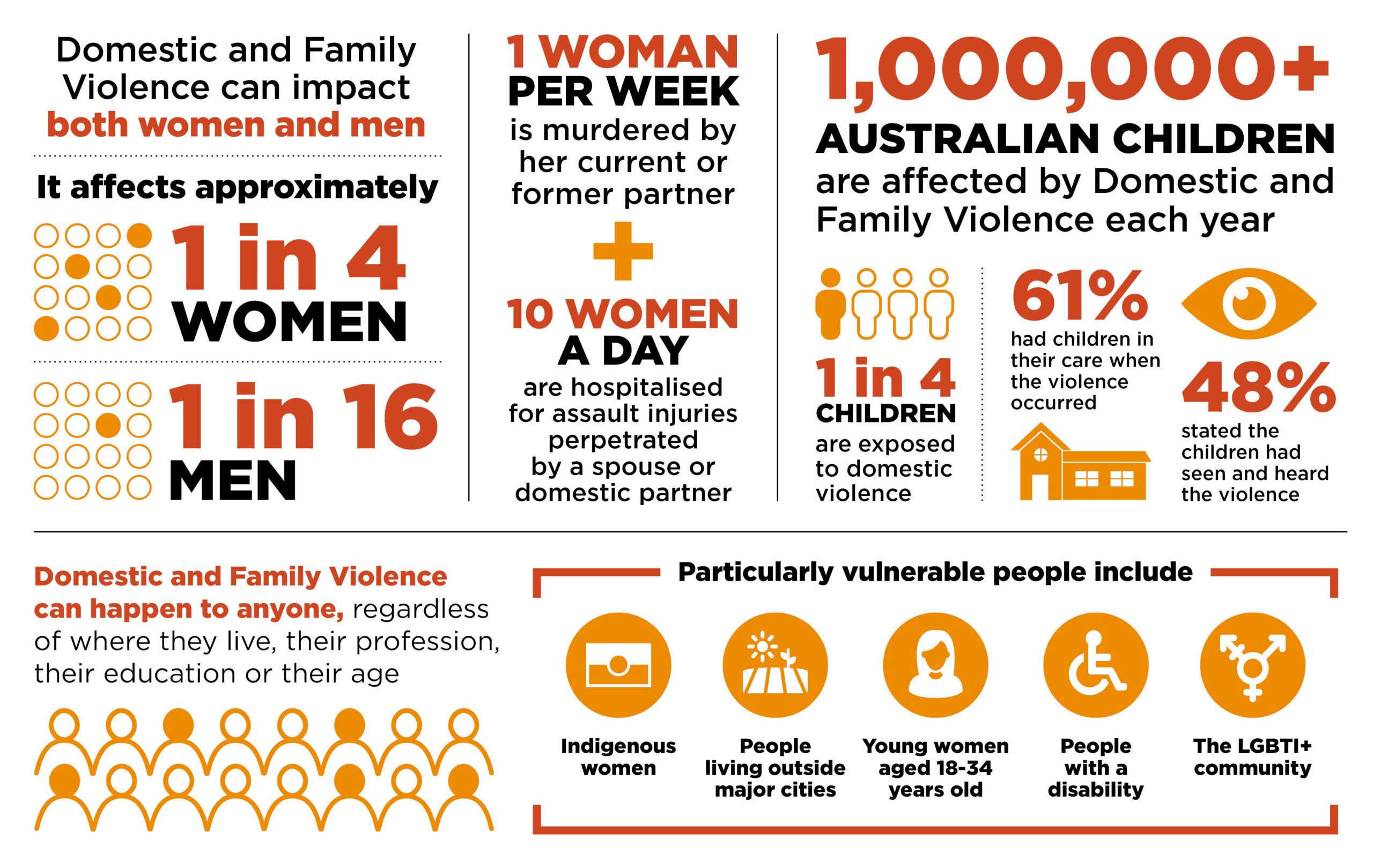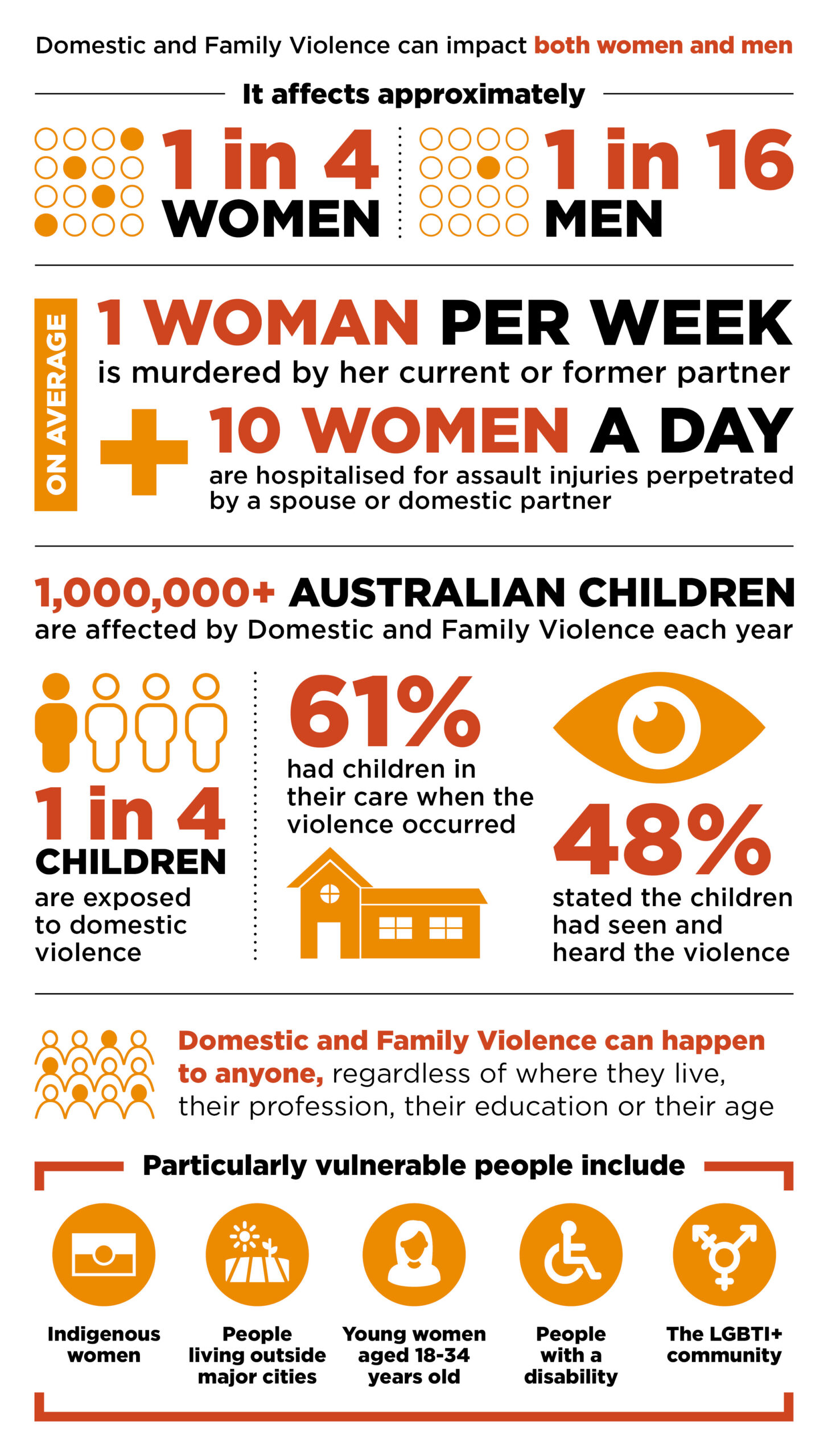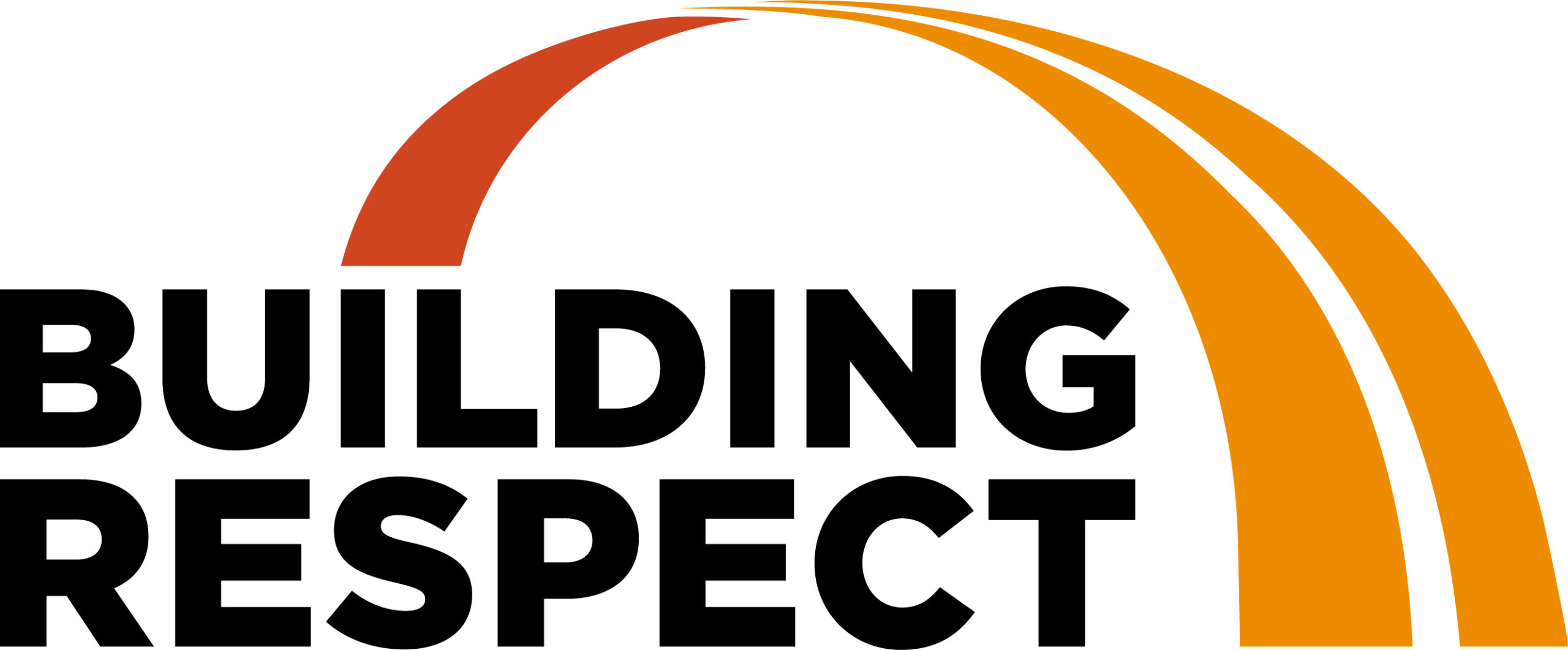What is domestic and Family Violence?
Domestic and Family Violence is a complex and confronting topic. It means acts of physical violence, control, verbal abuse and intimidation. The bottom line is that abusive behavior is never acceptable, whether from a man, woman, teenager, or an older adult. We all deserve to feel valued, respected, and safe.
Domestic violence and abuse can happen to anyone; it does not discriminate. It occurs within all age ranges, ethnic backgrounds, and economic levels.
We understand that some people in the construction industry may be affected, either through their relationship or by growing up with Domestic and Family Violence in their household.
If you have been impacted and need help, these resources are here to support you.
It is also important for us to support people who are using violence to address their behaviour and make changes to be the best person they can be.


What is Domestic & Family Violence?
Types of Domestic & Family abuse
Abuse can happen in all types of relationships:
Intimate personal relationships
This includes relationships between people of the same or opposite sex, of any age, who are married, de facto, engaged, housemates or dating. It also includes parents of a child, whether they live together or not, or are divorced or separated.
Family relationships
This includes relationships by blood, marriage, extended family, kin or clan on cultural or religious grounds.
Informal care relationships
This includes providing or receiving unpaid care for someone due to illness, disability or impairment. For more information, view the VIDEO: Beyond family relationships
Domestic and Family violence can include the following types of abuse, including both physical and non-non-physical acts:
• Emotional abuse – controlling someone’s feelings and causing angst or mental trauma
• Physical abuse – causing physical pain or injury to a person
• Financial abuse – withholding someone’s access to money or controlling the way they spend their money. For more information watch the VIDEO: Financial Abuse Support Toolkit
• Social isolation – cutting someone off from their family and or social circle or restricting access to contact with them
• Sexual abuse – unwanted sexual activity, perpetrated by force, the use of threats or a lack of consent
• Psychological abuse – the use of tactics to control someone’s way of thinking
• Spiritual abuse – preventing someone from following a spiritual practice or coercing them to follow one
• Identity-based abuse – abuse based upon someone’s race, gender, sexuality, age or other identity factors
• Coercive control – an act or a pattern of assault, threats, humiliation and intimidation or other abuse that is used to harm, punish, or frighten their victim. VIDEO: Policing Domestic and Family Violence Qld Police Service
• Verbal abuse – name-calling, threats, insults or verbal intimidation. See more information here
• Technology-based abuse – controlling behaviour by using technology to coerce, stalk or harass another person. For more assistance
Domestic & Family Violence does not discriminate
Domestic and Family Violence is a significant issue in Australia, impacting both women and men, but significantly more women. It affects approximately 1 in 4 women and one in 16 men.
Domestic and Family Violence can happen to anyone, regardless of where they live, their profession, their education or their age.
Those particularly vulnerable include:
-
- indigenous women
- people living outside major cities
- young women aged 18-34 years old
- people with a disability
- the LGBTI+ community
What are the impacts of Domestic & Family Violence?
The impacts of Domestic and Family Violence can extend across a person’s life. These impacts may include:
-
- physical injury (in extreme cases, victims lose their lives)
- a loss of confidence
- reduced connection to family and friends
- financial issues
- damage to their career
- loss of their home
- interrupted/changes to time with their children
The other major concern is children and young people who experience Domestic Violence and they are often at increased risk of being abused themselves. Children in violent households are forced to assume responsibility beyond their years. All children have the right to be safe and protected from Domestic and Family Violence.
- These impacts can exist for a long time, in some cases for years after a person leaves the situation. It is therefore important to understand what Domestic and Family Violence means so that we can provide empathy and support for those who are impacted. VIDEO: The Impact of Domestic and Family violence
What are the warning signs?
Domestic and Family Violence is complex, and these warning signs are not clear cut. Someone may exhibit warning signs and not be impacted by Domestic and Family Violence. And someone may be impacted by Domestic and Family Violence but not display these warning signs. There are several warning signs that may indicate someone is impacted by Domestic and Family Violence.
-
- Changes to their attendance – arriving late, leaving early, unexplained absence, working longer hours, short notice for time off
- Reduced outputs or quality of work
- Visible changes – use of bruises or injuries, using makeup or covering up with long sleeves
- Behavioural changes – drugs and alcohol, poor sleep, different mood, isolation from colleagues
- Being guarded or worried when discussing home life
- Frequent interruptions or harassment at work
- Signs of mental health issues – anxiety, depression
- Isolation from family and friends
- Limited or impaired access to finances
Please note: Due to the complex nature of DFV, someone may exhibit one or more of these warning signs and not be impacted by DFV, or they may be impacted by DFV and not display any of these warning signs. VIDEO: Warning Signs
-
If you think you may be impacted by Domestic and Family Violence, please contact your leader, manager or HR department for support.
If you are in immediate danger, phone the police on Triple Zero (000).
There is also a QUICK EXIT button on each page of this website for your safety.
What are the warning signs of someone using Domestic & Family Violence?
Domestic and Family Violence is a serious issue, and one that QMCA and its members are committed to addressing. This includes the need to address employees who may be using violence as well as supporting those who are impacted.
The health and safety of employees is paramount, and therefore it is essential that employees do not put themselves at risk when discussing this matter with someone who may be using violence.
If you have concerns about the behaviour of a co-worker, please reach out to your leader or HR Department for a confidential conversation.
For help and advice:
• find a local support service
• call a DFV helpline like 1800 RESPECT (1800 737 732) Mensline on phone 1300 78 99 78 or No To Violence (1300 766 491)
Many times the warning signs may not be clear, someone may display some of these signs but not be using violence. Or someone may be using Domestic and Family Violence but not exhibit these warning signs.
However, these are common signs of a person who is using violence:
-
- Changes to work attendance
- Reduced work outputs and/or quality
- Spending time at work constantly texting or calling partner
- Has injuries but explanations don’t align
- Bullying behaviour towards colleagues
- Talking negatively, behaving with disrespect or acting with violence towards the victim
- Not taking responsibility for their violence or minimising their actions
- Jealousy and possessiveness
- Lack of support for gender equality
What do these terms mean?
Abuse: to insult, hurt, injure, rape and/or molest another person. This may include physical abuse, emotional abuse, financial abuse, spiritual abuse and/or verbal abuse.
Person impacted by domestic violence (victim): a person who is affected by violence or children who witness domestic violence
A person using violence (perpetrator): a person who uses abusive behaviours to exert power and control over another person.
Coercion: when one person attempts or forces another to think or act in a different way.
Domestic and Family Violence (DFV): behaviours used by an abuser to gain or maintain power and control over or harm another person with whom they are having an intimate or family relationship.
Domestic and Family Violence Service Provider or specialist support service: an organisation that provides support, counselling and practical assistance to victims of Domestic and Family Violence.
Safety Plan: a plan, verbal or written, a victim of Domestic and Family Violence creates (either alone or with an advocate) with action steps to keep them and any impacted children safe when violence takes place or to prevent violence from happening.
Safe word: a code word that tells a friend, family or neighbours that you feel unsafe and need assistance.
Sexual Assault: any unwanted sexual activity forced on one person by another.
How can Building Respect help?
Over the last ten years, Australia has seen an increase in awareness about Domestic and Family Violence in news headlines and annual marches. There have also been significant changes in policy, planning, legislation, and Government funding.
Considering the significant statistics, we understand that people working in the construction industry may be affected, either through their relationship or by growing up with Domestic and Family Violence in their household. If you have been impacted and need help, we are here to support you.
Under the National Fair Work Act there is now a Domestic and Family Violence leave entitlement; employees dealing with the impact of Domestic violence can now:
-
- take unpaid Domestic and Family Violence leave
- request flexible working arrangements
- take paid or unpaid personal/carer’s leave in certain circumstances.
Please discuss the situation with your Leader, Manager or HR team, for any further support and guidance or check your employers DFV Policy.
What can a workplace do?
Workhaven video
Debunking the MYTHS about DFV
MYTH: I shouldn’t get involved in a private family matter.
FACT: The criminal code covers crimes that may occur in a domestic context. It is not just a family problem. It can have serious repercussions for your colleague, friend, their children and the whole community. The law aims to stop DFV from occurring, to maximise the safety of people subjected to domestic violence, and to make sure that perpetrators are held accountable for their behaviour.
MYTH: They must be doing something to provoke the violence.
FACT: Abusive behavior is never acceptable. Problems exist in many relationships but using violence to resolve them shows a lack of respect for the other person. Violence is a choice and we can all choose to not act violently.
MYTH: If it is so bad, they can just leave.
FACT: For anyone trying to end a relationship, it isn’t easy and leaving a violent relationship is even harder. The person may still love their partner and believe that the violence will end soon. They may be financially dependent on their partner and if they leave, they will not be able to afford rent. They may not know there is support available or the social or justice systems may have been unhelpful in the past. We need to offer support to people who are impacted by violence, whether they choose to leave the situation or not.
MYTH: Domestic and Family Violence happens because people get angry and lose control.
FACT: DFV is about gaining control over another person, not a loss of control. Using violence is a choice that the abuser makes.
MYTH: Alcohol or drugs cause domestic violence.
FACT: It is a misconception that domestic violence is caused directly by alcohol or substance abuse. Rather, they can make the situation worse or could eventually trigger intimate partner abuse in a violent individual. If someone blames alcohol or drugs they are avoiding taking responsibility for their actions – many people enjoy drinking and some may even drink excessively but they never use violence. Many people may stop their drinking and still keep using violence and controlling behaviours. While the use of alcohol and drugs can often make the violence more serious, it does not cause it.
MYTH: They don’t care about their children or they would leave.
FACT: A person impacted by violence is probably doing their best to protect their children from violence. They may feel that if the abuse is directed only at them and it will not affect the children. They may believe their children need both parents or lack the resources to support the kids on their own. The children may beg them to stay not wanting to leave their home or friends. The person may fear that if they leave they will lose custody of the children, or the children may be harmed.
MYTH: Children aren’t really affected by family violence between their parents.
FACT: Seeing violent behaviour carried out by one parent towards another can be very harmful to children. Studies show that if children live in a situation of DFV, they often develop anxiety or depression or have behavioural problems. The children may struggle to make and keep friends and often have learning difficulties at school.
MYTH: Women make false claims about family violence or exaggerate how bad the abuse is.
FACT: False claims about family violence are extremely rare. 80% of women who experience violence from a current partner don’t contact the police about it. When talking to family, friends and others, women are more likely to downplay their experience of violence than exaggerate it.
MYTH: I know the person and I really don’t think they could hurt anyone.
FACT: Many abusers are not violent in other relationships and are often likeable in social situations. However, they can be extremely violent towards their partner in the privacy of their home. The DFV victim may fear if they disclose the abuse to others, they won’t be believed because their partner appears to be a nice person. Abusers often use this against their partner, telling them ‘nobody will believe you’. Just because you’ve never seen someone behave abusively, don’t assume they don’t.
MYTH: If my colleague wanted my help, they would ask for it.
FACT: Your workmate or colleague may not want to confide in you, feeling you may not understand their situation. They may be ashamed of what’s happening and that may grow distant. If you suspect someone is impacted by Domestic and Family Violence, start the conversation in a gentle and general manner. Give your colleague or friend the choice to share their situation with you if they want to. A good question to begin with is “I’ve noticed you seem a bit different lately – are you OK?”
Information and support
What is Domestic and Family Violence?
I am affected by Domestic and Family Violence
I am a leader or manager wanting to learn more
I am supporting someone affected by violence
I am concerned about my behaviour
Building Respect at QMCA
If you think you may be impacted by Domestic and Family Violence, please contact your leader, manager or HR department for support.
